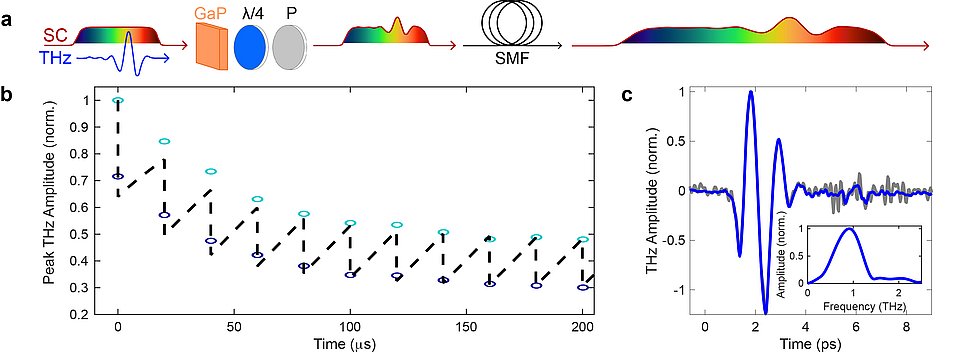When stretching rainbows reveal terahertz fingerprints
Recording THz frames at 50 000 frames per second with a table-top experimental setup.

The so-called terahertz gap is a hard to access region of the electromagnetism spectrum, located between infrared light and microwaves. It is of particular interest because many materials exhibit low energy resonances in this range, which are often referred as « fingerprints », revealing their identity. Non-invasive, the terahertz radiation is therefore a good candidate for sensing or to characterize materials without affecting them. It could also be a remarkable tool to study complex dynamics of chemical molecules providing we could take a sequence of THz shots to reveal the temporal evolution of the sample under study.
In this collaboration between the Joly research group at MPL and FAU on the one hand, and the Ménard Research group at the Max Planck - uOttawa Center for Extreme and Quantum Photonics on the other hand, the authors realized a slow-motion movie of sub-millisecond dynamics of hot carriers injected in silicon by sequentially recording THz frames at 50 000 frames per second with a table-top experimental setup. This strongly contrasts previous demonstrations of such fast THz spectroscopy, which relied on synchrotron facilities to provide THz sources with large enough intensity to allow for the detection of individual shots. Here, a THz pulse probes the sample before it is imprinted onto a broad chirped supercontinuum in the optical domain. This large spectrum contains well arranged wavelengths, like in a rainbow. The trick here is to use an optical fiber to stretch the optical supercontinuum, which now contains the THz information, in order to map those spectral features in the time domain and use a state-of-the-art oscilloscope to eventually extract the spectral information at a very high repetition rate.
This demonstration paves the way to monitoring both fast and non-reproducible phenomena occurring during phase transitions, chemical reactions, or protein folding in biochemistry.
Original publication:
https://doi.org/10.1038/s41467-023-38354-3
Image courtesy of Couture, N., Cui, W., Lippl, M. et al., Nat Commun 14, 2595 (2023).
Contact
Edda Fischer
Head of Communication and Marketing
Phone: +49 (0)9131 7133 805
MPLpresse@mpl.mpg.de





